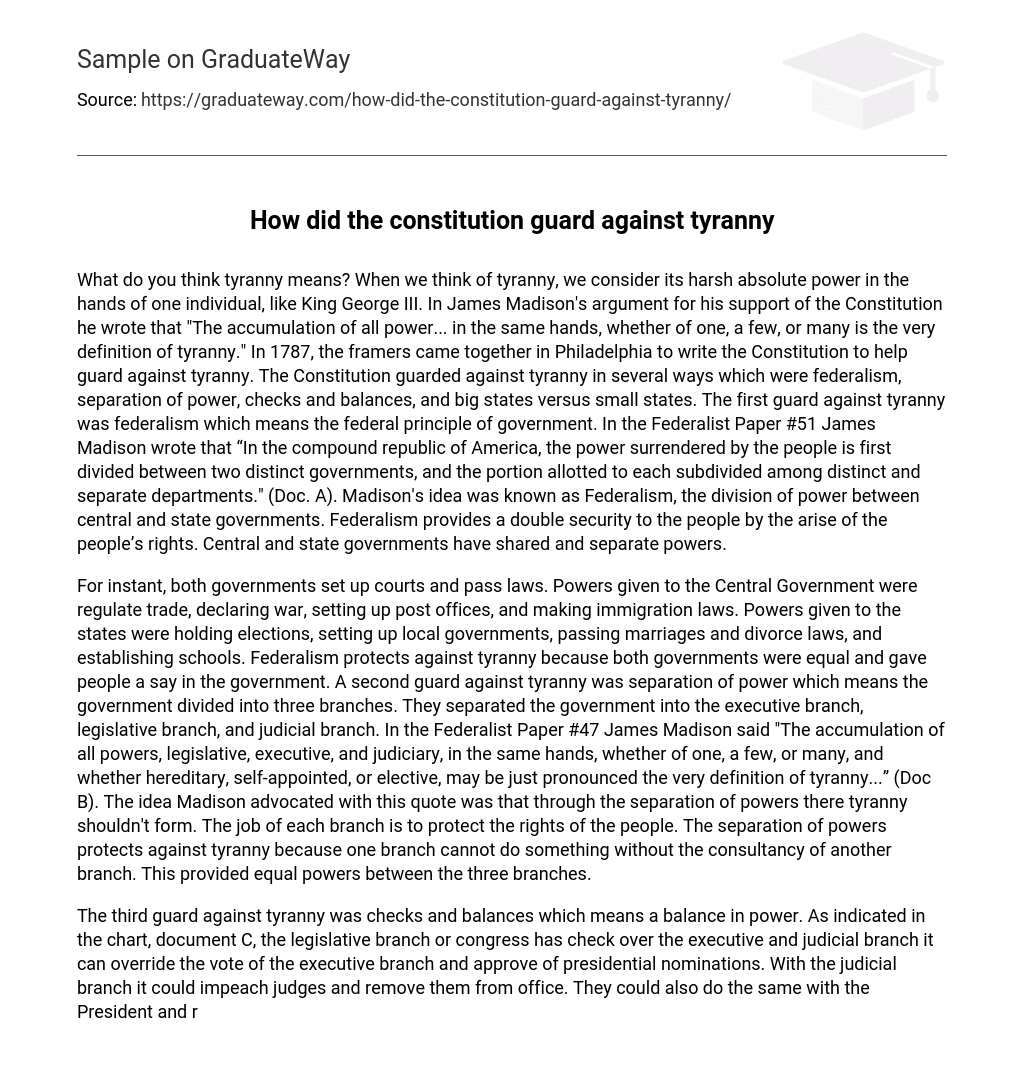When we think of tyranny, we imagine the absolute authority held by a single person, like King George III. James Madison argued in support of the Constitution and stated that “The accumulation of all power… in the same hands, whether of one, a few, or many is the very definition of tyranny.” In 1787, the framers met in Philadelphia to draft the Constitution and protect against tyranny. They included safeguards such as federalism, separation of power, checks and balances, and representation for big and small states. Federalism was their initial defense against tyranny. In Federalist Paper #51, Madison explained that “In the compound republic of America, the power surrendered by the people is first divided between two distinct governments…” (Doc. A). This concept referred to dividing authority between central and state governments. Federalism ensures people’s rights are protected through a dual security system where both central and state governments have shared and independent powers.
Both governments established courts and passed laws. The Central Government was given powers to regulate trade, declare war, set up post offices, and make immigration laws. The states were granted powers to hold elections, establish local governments, pass marriage and divorce laws, and establish schools. Federalism safeguards against tyranny by ensuring equality between the two governments and giving people a voice in governance. Another safeguard is the separation of power into three branches: executive branch, legislative branch, and judicial branch. James Madison argued in Federalist Paper #47 that tyranny arises when all powers are consolidated in one entity. The separation of powers prevents this by assigning distinct roles to each branch in protecting individuals’ rights. By mandating consultation among branches, it ensures their equal authority.
The third guard against tyranny, checks and balances, ensures a balance of power. Document C shows that the legislative branch can check the executive and judicial branches by overriding the executive’s vote and approving presidential nominations. Congress also has the authority to impeach judges and remove them from office, as well as remove the President. On the other hand, the executive branch can appoint judges to the Supreme Court and veto Congressional legislation. The judicial branch has the power to declare laws and presidential acts unconstitutional. James Madison emphasized that each branch should have constitutional control over one another to prevent tyranny (Doc C). This debate sparked discussions on representation of states in congress during the Constitutional Convention; ensuring smaller states’ votes or suggestions were not disregarded by larger states was a central concern.
During the Constitutional Convention, an agreement called the Great Compromise was reached. This agreement stipulated that representation in the House of Representatives would be based on population, satisfying the larger states. The smaller states were pleased as well because it ensured equal representation by having two senators per state in the Senate of the United States. This compromise brought unity among all states and served as a deterrent against tyranny.
At the Convention, delegates including Madison utilized various arguments such as federalism, division of powers, checks and balances, and disputes between larger and smaller states to safeguard against tyranny. While checks and balances and disputes between states play important roles in preventing tyranny, the most crucial factor is the separation of powers. By separating powers, the delegates effectively prevented any single group from gaining complete control, thus protecting our rights.





